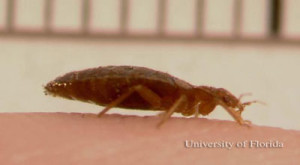 Bed Bug
Bed Bug
Sometimes referred to as “red coats,” “chinches,” or “mahogany flats” (USDA 1976), bed bugs, Cimex lectularius Linnaeus, are blood feeding parasites of humans, chickens, bats and occasionally domesticated animals (Usinger 1966). Bed bugs are suspected carriers of leprosy, oriental sore, Q-fever, and brucellosis (Krueger 2000) but have never been implicated in the spread of disease to humans (Dolling 1991). After the development and use of modern insecticides, such as DDT, bed bug infestations have virtually disappeared. However, since 1995, pest management professionals have noticed an increase in bed bug related complaints (Krueger 2000).
The adult bed bug is a broadly flattened, ovoid, insect with greatly reduced wings (Schuh and Slater 1995). The reduced fore wings, or hemelytra, are broader than they are long, with a somewhat rectangular appearance. The sides of the pronotum are covered with short, stiff hairs (Furman and Catts 1970). Before feeding, bed bugs are usually brown in color and range from 6 to 9.5 mm in length. After feeding, the body is often swollen and red in color (USDA 1976).
The photos and information above were provided by the University of Florida ![]()
